
Phononic materials exhibit mechanical properties that alter the propagation of acoustic waves and are widely useful for metamaterials. To fabricate acoustic materials with phononic bandgaps, colloidal nanoparticles and their assemblies allow access to various crystallinities in the submicrometer scale. We fabricated anisotropic crystals with dumbbell-shaped nanoparticles via field-directed self-assembly. Brillouin light spectroscopy detected the formation of direction-dependent hypersonic phononic bandgaps that scale with the lattice parameters. In addition, the local resonances of the constituent nanoparticles enable metamaterial behavior by opening hybridization gaps in disordered structures. Unexpectedly, this bandgap frequency is robust to changes in the dumbbell aspect ratio. Overall, this study provides a structure–property relationship for designing anisotropic phononic materials with targeted phononic bandgaps.
SEM image of a crystal of self-assembled dumbbell particles (lobe diameter: 210 &219 nm) with schematic illustration of phonon propagation parallel (blue) and normal (red) to the dumbbell long axis. The dispersion diagram reveals to types of stopbands: an isotropic hybridization due to particle quadrupolar resonance and periodicity induced direction dependent Bragg gap at higher frequencies.Figure 1 | SEM image of a crystal of self-assembled dumbbell particles (lobe diameter: 210 &219 nm) with schematic illustration of phonon propagation parallel (blue) and normal (red) to the dumbbell long axis. The dispersion diagram reveals to types of stopbands: an isotropic hybridization due to particle quadrupolar resonance and periodicity induced direction dependent Bragg gap at higher frequencies.
https://pubs.acs.org/doi/10.1021/acsnano.3c05750
https://doi.org/10.1021/acsnano.3c05750


